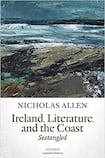
“At the dawn of Western narrative, Homer’s Odysseus sets sail.” So begins Margaret Cohen’s The Novel and the Sea (2012). Robert Graves would not have agreed. “English poetic education,” he argued in 1948, “should, really, begin not with the Canterbury Tales, not with the Odyssey, not even with Genesis, but with the Song of Amergin” – an Old Irish incantation said to have been recited by the bard Amergin as the Milesians invaded Ireland. “I am Wind on Sea/ I am Ocean-wave,/ I am Roar of Sea.”
Nicholas Allen’s Seatangled returns Irish literature to its coastal beginnings, imagining a “liquid” island whose “waterborne narratives” need to be recovered, reimagined and retold. It is part, then, of an ecological turn in international literary studies that brings into view the watery contours of art, culture and environment at a time of rising sea levels and a degraded marine environment.
Ireland, he suggests, forgot its own island identity. He quotes a story told by artist and cartographer Tim Robinson about his first visit to Inis Mór, when he and his wife, Máiread, “met an old man who explained the basic geography: ‘the ocean’, he told us, ‘goes all around the island’.” But even that “basic geography” seems to have eluded 20th-century Ireland, when a national focus on land, soil and territory led to a kind of sea-blindness.
This may seem surprising for a society and culture so often represented as insular, not to mention one that made a fetish of the older worlds still alive on the Blaskets and other offshore islands. But Allen is uninterested in such tensions and ironies, offering instead an argument that operates on non-national scales: the book is attuned to the archipelagic intimacies of Ireland’s relationship with Britain, to the sea as vehicle and metaphor of empire, and to highly local representations of rivers, lakes and rain.
Imperial decline
Seatangled’s argument (if I get the drift) is that early 20th-century writers registered the presence of the sea in the mode of imperial decline, as seen in the writings of WB Yeats and Erskine Childers. Then, in work by James Joyce and Jack B Yeats, literary and visual culture turned “porous”, absorbing the sights and sounds of the wide oceanic world.
Moving on to mid-century culture “at ebb tide”, Allen discerns an archipelagic quality in Seán Ó Faoláin’s editorship of the Bell, an interest in cross-island connections that connects Frank O’Connor with John Hewitt and yields an unusually full discussion of travel writer Robert Gibbings. Cork and Belfast emerge in this chapter as port cities whose maritime pasts were cast off by 20th-century territorial politics.
The discussion of the Troubles that follows identifies Seamus Heaney’s “porous places”, while the idea of “liquid underpinnings” also informs a discussion of novels that tell the story of Belfast from its shores. Recent fictions of translatlantic crossing include a discussion of Joseph O’Neill’s Netherland, “the greatest novel to engage with the liquid traditions of the literature without ever mentioning Ireland once”.
An admiring chapter on the poetry of Eiléan Ní Chuileanáin comes just at the right time for a reader wondering what has happened to the female writers, while discussions of novels by Hugo Hamilton, John Banville and Anne Enright stay on familiar Irish studies ground.
Barry’s stories
The “maritime circuit” of Kevin Barry’s stories allows Allen to return to the rain-sodden, river- and sea-inundated west of Ireland setting familiar from the book’s opening chapter on Yeats. A final chapter on the journal Archipelago (founded by poet Andrew McNeillie in 2007) discusses the cultural inscription of Irish and British coasts from Norman Ackroyd’s drawings to Sinéad Morrissey’s poetry.
This is a book that ranges widely as Nicholas Allen darts between “the many moments of transition between land and sea” that crowd his pages. Those transitions in turn map on to other relationships: between nation and empire, sea and ocean, north and south, Ireland and Britain.
Allen’s prose style is sometimes a victim of the tangled relationships that he seeks to trace. He adopts a variety of watery words to allow him to feel his way around his material – flights of language that can leave the reader feeling rather submerged beneath their flow. The book’s co-ordinates are plotted from the sea, and the experience of reading it can resemble the confusion experienced when you look at a naval chart and realise that sea, so often that which shapes the space around the land, is itself the subject of the image.
Brimming with ideas, names and points of reference, Seatangled is an agenda-setting book that will help return the study of modern Irish writing to the coast.
Claire Connolly is professor of modern English at University College Cork and editor of Irish Literature in Transition, 1780-1820 (Cambridge University Press)









